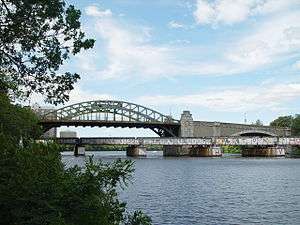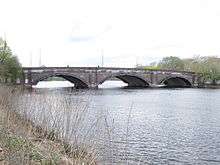Head of the Charles Regatta
| Head of the Charles Regatta | |
|---|---|
 | |
| Date | Penultimate Weekend of October |
| Location | Boston, MA |
| Event type | Head Race |
| Distance | 3 miles |
| Primary sponsor | BNY Mellon |
| Established | 1965 |
| Official site | www.hocr.org |
| Participants | 2,083 entries; 714 clubs [1] |



The Head Of The Charles® Regatta, also known as HOCR, is a rowing head race held on the penultimate complete weekend of October (i.e., on the Saturday that falls between the 17th and the 23rd of the month, and on the Sunday immediately afterwards) each year on the Charles River, which separates Boston and Cambridge, Massachusetts. It is the largest 2-day regatta in the world, with 11,000 athletes rowing in over 1,900 boats in 61 events. It attracts tens of thousands of spectators during regatta weekend.
The last races of the Regatta are generally the most prestigious: Championship 4s, and Championship 8s (both men and women). Championship sculling events (1x/single and 2x/double) race on Saturday afternoon. The Championship events usually include U.S. National Team athletes, as well as national team athletes from other top rowing nations.
The competitive field includes individual and team competitors from colleges, high schools, and clubs from nearly all American states and various countries. The 2006 field included rowers from China, South Africa, Croatia, Ireland, and the Netherlands. The age of athletes spans from 14 to 85 years old with experience levels from novice to Olympic. In 2007, approximately 10% of the field was international.
Regattas such as the Head of the Charles in Boston and the Head of the Schuylkill in Philadelphia are to the rowing world what the New York Marathon and the Boston Marathon are to running.— Susan Saint Sing, The Eight: A Season in the Tradition of Harvard Crew[2]
Course
The course is 3 miles (4,800 meters) long and stretches from the start at Boston University's DeWolfe Boathouse near the Charles River Basin to the finish just after the Eliot Bridge and before Northeastern University's Henderson Boathouse. The course is renowned for being challenging for crews to navigate without incident or penalty. The course contains 6 bridges, which appear in this order from the start:
The Weeks and Eliot Bridges fall at sharp turns in the course, and collisions occur here more than any other part of the course.
Racing regulations
Crews start the race at 15-second intervals. The starting order is based on the crew's finishing time in the previous year, with the top finisher from the prior year leaving first, the second finisher leaving second, and so on. Crews that did not compete in the prior year are seeded after all prior year entrants in a random order, although race organizers have some discretion in the seeding process. Having presumably faster crews start ahead of presumably slower crews reduces the amount of passing boats must make during the race, reducing the potential for boating accidents. However, passing almost always occurs, and penalties are imposed on crews that do not follow passing regulations, such as failing to yield to a boat that closes to within one boat length of open water.[3]
History
The First Year
The Head of the Charles Regatta was first organized in 1965 by Cambridge Boat Club members D'Arcy MacMahon, Howard McIntyre, and Jack Vincent. The members of the boat club thought that a fall regatta would be an entertaining way to break up the monotony of the training season for colleges and boat clubs in the area. D'Arcy MacMahon had been the captain of the University of Pennsylvania's lightweight varsity three seasons earlier. They initially had little hope the regatta would be a success, it was the wrong time of year and it wasn't expected to draw any spectators.[4]
Harvard University sculling instructor Ernest Arlett provided the idea for the head race. George Ernest Arlett came to the US because in England only "gentlemen" could race. Even when Arlett brought Northeastern University's rowing team to Henley Royal Regatta and the team members were invited, the team entered by the front door and Mr. Arlett still had to enter by the rear or servants door. Class snobbery or pedigree was still in force.
Despite their reservations, the founders of the regatta were determined to see it become a success. In an interview with New York Times, Jerry Olrich and MacMahon identified that this regatta was "destined to become a classic"[5]
The Regatta expanded to a two-day event in 1997.
In 1991, Frederick V. Schoch was appointed Executive Director of the Regatta, and he continues to oversee the event.[6]
Charity program
Since 1998, the Head of the Charles Regatta's Charity Program has generated over $650,000 for its official charities, which include Cambridge Community Foundation and Community Rowing. The Charity Program allows competitors to gain an automatic entry into the Regatta in exchange for raising $1250 per person, per entry. The official rules allow any single, double, four, or eight is eligible to enter.
Before 1965 they use to have power boat races that included hydroplane and utility class boats.
Awards
First place medals are awarded to winning competitors in each event category of the race. The first place medals are struck bronze medallions that are 2.5 inches in diameter. They show a single sculler from above on the front, and are engraved with the year and event on the back. Only the first place medals are distributed at the Regatta on Saturday and Sunday evenings following the races. Medals for second and third place medallions are of the same design, but are 1.75 inches in diameter. The Regatta issues additional medals according to the number of entries in the race as well. For instance, in a race with 50 competitors, 5 medals are issued.
Special medals are issued to the most competitive Youth scullers; the most competitive Grand-Veteran scullers in the Senior-Veteran Singles Event; the fastest Veteran crews in the Senior-Master 2x, 4+, and 8+ events; the fastest Grand-Master crews in the Senior-Master 2x, 4+, and 8+ events; and the fastest collegiate crews in the Championship Fours and Eights events.
Course records
| Event | Men | Women | Mixed event |
|---|---|---|---|
| Club Singles | Nat Keohane 18:17.14 (1997) | Josee Paquette 20:36.59 (1997) | |
| Club Fours | Union Boat Club 16:05.311 (2013) | Saugatuck Rowing Association 18:42.95 (1997) | |
| Club Eights | Onota Lake Rowing Association (Williams College Men) 14:56.49 (1997) | Radcliffe 16:41.930 (2013) | |
| Youth Doubles | Ruben Steinhardt/ Martin Barakso 16:58.864 (2010) | E. Sharis/ B. Baustian 18:59:357 (2010) | |
| Youth Fours | U.S. Naval Academy 16:23.9 (1994) | Community Rowing, Inc. 17:19.960 (2001) | |
| Youth Eights | Marin Rowing Association 14:50.246 (2010) | Community Rowing, Inc. 16:49.056 (2010) | |
| Master Singles | Robert Spousta 18:16.9 (1984) | Cynthia Matthes 19:55.24 (1997) | |
| Master Doubles | M. Smith/ D. Gorriaran 17:13.68 (2003) | T. Zarzeczny-Bell/ S. Remmler 19:00.316 (2007) | |
| Master Fours | Belfast Rowing Club 17:03.38 (1997) | Portland Boat Club 18:54.35 (1995) | |
| Master Eights | Molesey Boat Club, England 15:14.86 (2012) | Long Beach RA 17:14.17 (2001) | |
| Grand Master Singles | Lawrence Klecatsky 18:54.3 (1992) | Judy Geer 21:30.930 (2007) | |
| Senior Master Singles | Gregory Benning 18:19.758 (2007) | Margarita Jekabsons 20:18.04 (2003) | |
| Senior-Master Doubles | R. Haberl/ R. Slocum 18:06.910 (2007) | J. Linse/ S. Kinne 19:53.749 (2007) | |
| Senior-Master Fours | Toronto Sculling Club 17:25.52 (2003) | Watercat Rowing Club 19:48.392 (2007) | |
| Senior-Master Eights | Team Attager 15:43.490 (2007) | 1980 Rowing Club 18:00.427 (2007) | |
| Grand-Master Eights | Melbourne University Boat Club 16:30.62 (2013) | ||
| Veteran Singles | C. Collins 19:24.329 (adjusted) (2001) | Brook Stevens 23:25.66 (adjusted) (2007) | |
| Senior Veteran Singles | R. Kendall 20:31.75 (adjusted) (2001) | L. Rindlaub (70 +) 25:34.773 (adjusted) (2007) | |
| Collegiate Fours | University of Virginia Rowing Association 16:26.287 (2013) | Marquette University 19:19.167 (2007) | |
| Collegiate Eights | Florida Institute of Technology 14:43.373 (2010) | Queen's University, Canada 16:47.321 (2003) | |
| Lightweight Singles | Paul Fuchs 17:24.8 (1984) | Teresa Zarzeczny 19:00.58 (1992) | |
| Lightweight Fours | New York Athletic Club 15:49.63 (2003) | Undine Barge Club 17:54.864 (2010) | |
| Lightweight Eights | Princeton University 14:09.921 (2010) | University of Wisconsin 16:06.102 (2010) | |
| Championship Singles | John Biglow 17:29.8 (1982) | Virginia Gilder 18:45.6 (1982) | |
| Championship Doubles | Martin Sinkovic and Valent Sinkovic 15:40.56 (2014) | A. De Zwager/J. Rumball 17:51.46 (2003) | |
| Championship Fours | Princeton Training Center 15:34.4 (1997) | London Training Center 17:27.35 (2003) | |
| Championship Eights | USRowing 13:58.99 (1997) | USRowing 15:26.572 (2007) | |
| Alumni Eights | Northeastern University Alumni 15:13.543 (2009) | University of Michigan Alumni 15:56.65 (2014) | |
| Directors' Challenge Quads | G-Man Systems (32) 14:56.193 (2010) | Mygatt/Styver/Gay/Matia 17:16.370 (2006) | Next Year 15:40.161 (2010) |
| Directors' Challenge Doubles | Parent/Child Division: C. Hamlin, A. Hamlin 17:51.10 (2008) | G. DeAngelis, K. Collins 17:10.20 (2008) |
Notes
- ↑ "49th Head of the Charles". Regatta Central. Retrieved 2 November 2013.
- ↑ Saint Sing, Susan (2010). The Eight: A Season in the Tradition of Harvard Crew. New York, N.Y.: St. Martin's Press. p. 24. ISBN 9780312539238. Retrieved 10 November 2013.
- ↑ "Head of the Charles Regatta Rules and Regulations". hocr.org.
- ↑ Powers, John (2015). Head of the Charles Regatta, First 50 (3 ed.). HOCR. ISBN 9780692458570.
- ↑ Powers, John (2015). The Head of the Charles; First 50. HOCR. ISBN 9780692458570.
- ↑ A better source for the History of this regatta is in "Yankee Magazine", September/October issue 2013.
External links
- Head of the Charles Regatta
- Row2k Head of the Charles coverage
- Live Video Webcasts of the Head of the Charles Regatta on NESports.tv a division of Bullpen Media
Coordinates: 42°21′45″N 71°7′1″W / 42.36250°N 71.11694°W

